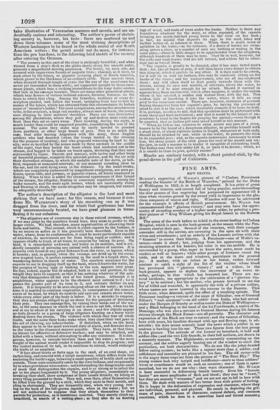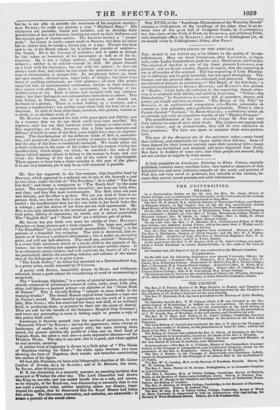FINE ARTS.
NEW PRINTS.
BURNET'S engraving of Wri.xm's picture of " Chelsea Pensioners reading the Gazette of the Battle of Waterloo," painted for the Duke of Wellington in 1822 is at length completed. It is a print of great beauty and interest, and cannot fail of being popular, notwithstanding. the slow process of line engraving has postponed its appearance till a time when victories gained by the sword yield in importance to the glo- rious conquests of reason and right. Waterloo will ever be celebrated for the example it affords of British perseverance. Mr. WILKIE has commemorated that " glorious victory," and may soon have the oppor- tunity of recording another of a higher moral order, by painting a pen- dant picture of "King William giving his Royal Assent to the Reform Bill."
The scene of the work before us is laid in the street leading to Chelsea Hospital, which is seen in the back-ground, at the season when the Pen- sioners receive their pay. Several of the veterans, with their younger comrades still in the service, are carousing in the open air with their wives and sweethearts ; and an orderly of the Lancers arrives with the " Gazette" to crown their hilarity. A Pensioner—one of Wolfe's ve- terans—reads it aloud ; but, judging from his appearance, and the straining attention of his hearers, his voice is not too audible. He is surrounded by a group, who, eager to know the news, must needs be readers as well as hearers ; while other groups of listeners round the table, and at the doors and windows, participate in the general joy. A mother, with an infant at her breast, rushes forward anxious to catch a sight of the list of the victims whose blood has purchased this " glorious victory ;" and a widow, in the back-ground, appears to deplore the recurrence of an event si- milar, perhaps, to that which has bereaved her. These are na- tural incidents, too appropriate to the celebration of a "glorious vic- tory" to be omitted ; but the mother, who presses forward to see the list of killed and wounded, is apparently the wife of a private soldier, whose names are never inserted in the returns in the Gazette. This little error, when detected, spoils the effect of a touching episode. The Pensioner reading—a veteran of the siege of Gibraltar, one of GeneraL Elliott's "rock scorpions"—an old soldier from India, who had served. under the Marquis of Granby as well as under the Duke of Wellington— and a Black belonging to the band of the 1st Foot Guards, a native of St. Domingo, who was also a servant to General Moreau during his famous retreat through the Black Forest—are all portraits. The character and expression of the Black are true to nature ; and the veteran of Gibraltar, bent with years, his faculties dimmed with age and flowing cups, is ad- mirable: his dozy senses scarcely heed the news which a soldier in an
undress is bawling into his ear. These two figures form the best group in the picture. The attitude of the Lancer on horseback, is bold and soldier-like ; and the two Life Guards, in their full uniform, are drawn in
a masterly manner. The Highlander, so earnestly commenting on the account, and the soldier eagerly leaning out of the window to catch the
particulars, are both characteristic. We do not like the jolter-headed fellow eating oysters ; he looks like a tapster more than a soldier, and selfishness and sensuality are pictured in his face. The old oyster-wife is the angry dame stept out from the picture of "The Rent Day." The. young women look very insipid and indifferent—more so than soldiers' wives or sweethearts would on such an occasion ; one of them is open-
mouthed, but we do not see why : they want character. Mr. WILKIE is least successful in delineating female beauty. Even his "bonnie lassies" are mere amplitudes of flesh and blood ; they may be " braw,'!:
but they are scarcelywinsome " and we are not apt to fall in love with them. He deals with matters Of fact better than with points of feeling.
He is happy in the delineation of expression and character, where they are individual, personal, and physical. He excels in depicting the gri- mace of pain, shrewdness of character, natural defects, and common emotions, which he does in a somewhat hard and foreed..rnanner4, 1:t.it he is not able to embody the sentiment of his inspired country:* man BURNS; he could not portray a true "Highland Mary." His characters are portraits, literal and faithful; and he develops their -peculiarities of face and manner, leaning too much to their littleness and the meaner parts of human nature. His has been termed a " pauper style." Its virtue is truth—exact truth to Nature; but then he treats her no better than he would a brown jug or a pan. WILKIE has been said to be of the Dutch school : he is rather the founder of another— the Scotch. He is the CRABBE of painters ; and it seems as though he had taken an inventory of his personages as well as of the ac- -cessories. He is not a vulgar painter, though he chooses homely .subjects ; neither is he refined—except in skill. He places himself on a level with his characters' but not with his subject : he does not always reach that, and unless he can catch the sentiment in some petty trap of circumstance, it escapes him. In the picture before us, there are open mouths, strained eyes, eager looks of delight ; but there is no burst of exulting enthusiasm, no wild gladness ; all seem like people surprised into an unaccustomed excitement, foreign to their natures ; they rejoice with effort ; there is no spontaneity, no kindling of the wildfire train of joy. Each is intent and occupied with one common topic; but their feelings do not communicate themselves to others. This may belong to Nature, but it is not universal, and should not be found in a picture. There is a man holding up a trumpet, and a woman a handkerchief; but neither wave them with the true air of en- thusiasm. In spite of these objections, however, this picture, viewed as a whole, is an excellent work of art.
Mr. BURNET has executed his task with great spirit and fidelity, and in a manner that we do not think could have been excelled. His vigorous style has not that hardness which belongs to some styles of line engraving ; we think, however, that a little more clearness and delicacy of finish in some of the flesh tones might have been an improve. silent. The discrimination of the different kinds of flesh is, neverthe- less well preserved; there is a good variety of texture in the engraving, and play of the lines is excellently managed. We would point out a little confusion in the arms of the widow and the woman waving her handkerchief, which might, we think, be remedied : the arm of the .figure behind appears almost to belong to the woman in front, and vice verse the drawing of the bent arm of the widow is objectionable. There appears to have been a slight mistake in this part of the plate ; -it is not very material, yet it may be as well corrected if possible.



























 Previous page
Previous page